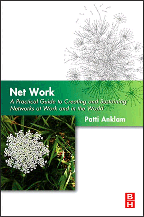Speaking about complexity and SNA/ONA
Thursday was a busy day. In the morning I presented a webinar to 60+ people in HP, the primary audience being the enterprise solution architects community. My former colleague Leo Laverdure, who has had a long-standing interest in complexity and evolutionary architecture, invited me to speak. I was able to cover the basics of Cynefin and social network analysis in the two hour slot, at least enough time to convey the concepts, framework and methods. The responses were quite good: an indication to me that there is a need to start introducing the ideas of complexity into the methods for enterprise and systems architecture. This theme enables me to reach back into my own roots in software development and provide a bridge in language and ontology between the two systems.
It was not my first experience delivering a talk over the web to an unseeable audience. However, the HP classroom software helps maintain interactivity and provides some sense of how people are perceiving the pace, what things people have questions about, and so on. The feedback was also immediate, and that helped, but nothing like being able to really see how people respond.
My evening slot, a presentation to the Boston OD Learning Group with Bruce Hoppe on social network analysis, was altogether different. In addition to short “burst-mode” powerpoint introduction to SNA and some case studies, we did a “real-time” SNA survey, collecting data as people came into the session and showing them the map at the end. We had also planned a yarn exercise to show OD specialists how they can create a live map with people in a room by having them string yarn between connections. Bruce took this idea “up a notch” and actually created a role-play that illustrated how executives would form a team in the face of a serious competitive threat.
We also had interactive break-out groups to have people talk with each other about what they already know about networks. Naturally, organizational development people have long understood how formal and informal networks impact productivity. It was a terrific conversation.
Being in the room was altogether different than speaking over the phone and focusing on the PC screen. The venue — Tufts Health in Waltham, MA — added an extra benefit. As people were in the breakouts, I cross the hall to check on one group. There, outside the cafeteria entrance, was a large poster proclaiming, “Large Social Networks May Help Women’s Hearts.” (Details on WebMD)




